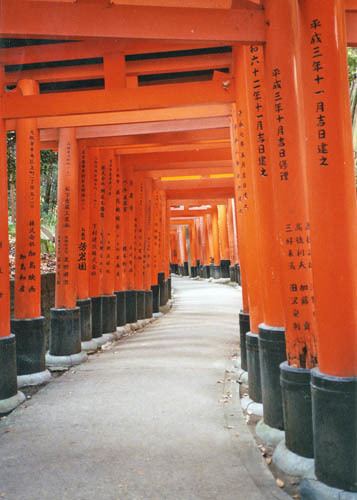 | ||
Similar Kentatsui Shrine, 豊中稲荷神社, Takenob Shrine, Fushimi Inari Taisha Ot, モルト・ボーノ 豊中稲荷神社 | ||
Fushimi inari shrine in kyoto all 10 000 gates explored only in japan 24
An Inari shrine (稲荷神社, Inari Jinja) is a shinto shrine to worship the god Inari. There are many Inari shrines in Japan. The deity is worshiped also in some Buddhist temples.
Contents
- Fushimi inari shrine in kyoto all 10 000 gates explored only in japan 24
- Hitaki sai fire festival at fushimi inari shrine
- Shrines and offerings
- Shinto
- Buddhist
- References
Hitaki sai fire festival at fushimi inari shrine
Shrines and offerings
Inari is a popular deity with shrines and Buddhist temples located throughout most of Japan. According to a 2007 report from Kokugakuin University, 2970 shrines are dedicated to Inari. This number includes only Shinto shrines that are registered as religious corporations and part of the Association of Shinto Shrines; if small roadside or field shrines, shrines kept in a home or corporate office, and Buddhist temples were included, the number might increase by an order of magnitude.
The entrance to an Inari shrine is usually marked by one or more vermilion torii and some statues of kitsune, which are often adorned with red yodarekake (votive bibs) by worshippers out of respect. This red color has come to be identified with Inari, because of the prevalence of its use among Inari shrines and their torii. The main shrine is the Fushimi Inari-taisha in Fushimi-ku, Kyoto, where the paths up the shrine hill are marked in this fashion.
The kitsune statues are at times taken for a form of Inari, and they typically come in pairs, representing a male and a female. These fox statues hold a symbolic item in their mouths or beneath a front paw — most often a jewel and a key, but a sheaf of rice, a scroll, or a fox cub are all common. Almost all Inari shrines, no matter how small, will feature at least a pair of these statues, usually flanking or on the altar or in front of the main sanctuary. The statues are rarely realistic; they are typically stylized, portraying a seated animal with its tail in the air looking forward. Despite these common characteristics, the statues are highly individual in nature; no two are quite the same.
Offerings of rice, sake, and other food are given at the shrine to appease and please these kitsune messengers, who are then expected to plead with Inari on the worshipper's behalf. Inari-zushi, a Japanese sushi roll of rice-packed fried tofu, is another popular offering. Fried tofu is believed to be a favorite food of Japanese foxes, and an Inari-zushi roll has pointed corners that resemble fox ears, thus reinforcing the association. Priests do not normally offer these foods to the deity, but it is common for shops that line the approach to an Inari shrine to sell fried tofu for devotees to offer. Fox statues are often offered to Inari shrines by worshippers, and on occasion a stuffed and mounted fox is presented to a temple. At one time, some temples were home to live foxes that were venerated, but this is not current practice. The Toyokawa Inari temple has a sign noting that live foxes were kept on site in the 1920s.
Shinto
The following are dedicated to the worship of Inari.
Buddhist
The following are Buddhist temples dedicated to the worship of Inari.
